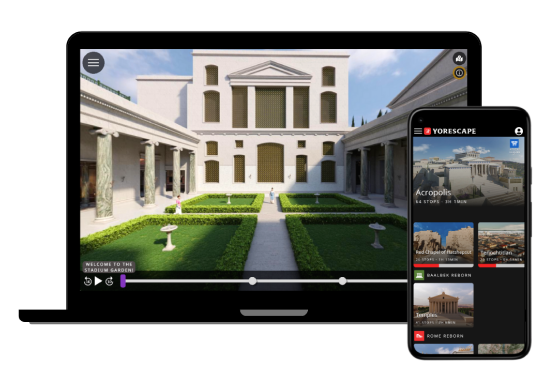
- Description
- Languages
- Credits
- Bibliography
Flyover Zone takes you on a virtual tour of the so-called Stadium Garden in Hadrian's Villa. As you’ll quickly see, the complex was neither a stadium nor a garden but–as the modern excavations revealed–an impressive complex of buildings richly decorated with sculpture. It was used in warm weather for imperial audiences, a place for strolling, and imperial banquets. Highlights of the tour include the South Nymphaeum with sixteen statues illustrating the tragic story of Niobe and her children; the South Hall, where you can see Hadrian presiding over an imperial audience; the North Hall, where you can see the one sculpture gallery known from the villa; the North Peristyle, which included an intimate dining room (triclinium) and even the emperor’s very own toilet. This tour includes nighttime views when the place was transformed by the artificial lights into one of the most enchanting parts of Hadrian’s government retreat. Your guide is Prof. Bernard Frischer, Director of the Digital Hadrian's Villa Project.
Audio: English
Subtitles: English, French, Italian, Spanish
Producer:
Bernard Frischer
Project Manager:
Bernard Frischer
Tour Guide/Narration:
Bernard Frischer
Script:
Bernard Frischer
3D Modeling:
Lasha Tskhondia
Art Direction:
Mohamed Abdelaziz
Contributors:
Davide Angheleddu
Carter Conoway
Allen Hahn
Captions:
Juliette Bolloch (French)
Ambra Spinelli (Italian)
Nancy Peniche May (Spanish)
Image Credits:
The Buti-Mengs engravings of the Villa Negroni frescoes appear with the kind permission of the Wellcome Collection.
The photograph of the "weeping rock" at Manisa, Turkey is by Carole Raddato (CC-BY-SA 2.0).
Created By:
Flyover Zone
Special Thanks:
BYA
Matthew Robert Brennan
Wilfred Geominy
John Herrmann
Brunilde Sismondo Ridgway
Marina Sapelli Ragni
Michael Ytterberg
the students in ARAH 4591 Spring Semester 2013 at the University of Virginia
Abguss-Sammlung Antiker Plastik (Berlin)
Collection des Moulages (Geneva)
French Academy in Rome (Villa Medici)
Museo dell'Arte Classica (Rome)
Skulpturhalle (Basel)
Slater Museum (Norwich, CT)
The team expresses gratitude to:
Adolf Hoffmann, for his epochal research on the Stadium Garden
- B. Adembri, “I marmi colorati nella decorazione di Villa Adriana,” in I marmi colorati della Roma imperiale, edited by Marilda De Nuccio and Lucrezia Ungaro (Marsilio, Venice, 2002) 471-474.
- B. Adembri and G. E. Cinque, “La decorazione parietale di un ambiente dell’Edifico con Tre Esedre,” in Villa adriana. Una storia mai finita, edited by Marina Sapelli Ragni (Electa, Milan, 2010) 200-203.
- S. Aurigemma, Villa Adriana (Libreria dello Stato, Rome, 1996) 143-145.
- M. T. Boatwright, Hadrian and the Cities of the Roman Empire (Princeton and Oxford 2000).
- F. Chiappetta, I percorsi antichi di Villa Adriana (Rome 2008).
- G. Cinque and E. Lazzeri, “Policromia marmorea nei rivestimenti pavimentali e parietali della Villa Adriana di Tivoli: Nuove scoperte e verifiche, “ ROMVLA 11 (2012) 161-204.
- D. R. Coffin, Pirro Ligorio (University Park, PA 2004).
- T. A. Davidson, Short Account of the Niobe Group (L. W. Schmidt, New York, 1875).
- F. De Visscher, "Héraclès Epitrapézios," L’Antiquité Classique 30 (1961) 67-129.
- E. Diacciati, “Copie, contesti e fruizione del Gruppo dei Niobidi in età imperiale,” Agoge 2 (2005) 197-264.
- E. Diacciati, “The Original Setting of the Niobid Group,” in A Theatre for Niobe. The Rebirth of a Regal Room in the Uffizi, edited by Antonio Natali and Antonella Romualdi (Giunti, Florence, 2009) 195-206.
- K. Fittschen and P. Zanker, Katalog der römischen Porträts in den Capitolinischen Museen und den anderen kommunalen Sammlungen der Stadt Rom (Philipp von Zabern Verlag, Mainz 1983).
- B. Frischer et al. The Digital Hadrian’s Villa Project; http://vwhl.soic.indiana.edu/villa/ (seen September 20, 2020).
- H. Gabelmann, LIMC III.1, s.v. “Endymion” (Artemis Verlag, Zurich and Munich 1986) 726-742.
- W. Geominy, Die Florentiner Niobiden (Diss., University of Bonn, 1982).
- W. Geominy, “Niobe,” “Niobidae,” in Lexicon Iconographicum Mythologiae Classicae (LIMC), vol. VI.1 (Zurich and Munich 1992) 908-929.
- W. Geominy, Lexicon Iconographicum Mythologiae Classicae (LIMC), Supplement I (Zurich and Munich 2009) 390-391.
- F. Guidobaldi et al. Sectilia pavimenta di Villa Adriana (Rome 1994).
- H.-V. Herrmann, Olympia, Heiligtum und Wettkampfstätte (1972).
- A. Hoffmann, Das Gartenstadion in der Villa Hadriana (Verlag Philipp von Zabern, Mainz 1980).
- N. Icard-Gianolio, LIMC III.1 s.v. “Psyche” (Artemis Verlag, Zurich and Munich 1986).
- D. E. E. Kleiner, Roman Sculpture (Yale University Press, New Haven 1992).
- A. O. Koloski-Ostrow, The Archaeology of Sanitation in Roman Italy. Toilets, Sewers, and Water Systems (The University of North Carolina Press, Chapel Hill 2015).
- D. Lambros, D. Moullou, and F. V. Topalis, "Artificial Light Sources in Roman, Byzantine, and Post-Byzantine Eras: An Evaluation of Their Performance," Chronos 32 (2015): 119-132.
- K. Lapatin and K. Wright, editors, The J. Paul Getty Museum. The Antiquities Collection, second edition (Getty Publications, Los Angeles 2010).
- P. Ligorio, Libro dell’antica città di Tivoli e di alcune famose villa, Edizione Nazionale delle Opere di Pirro Ligorio, vol. 20, ed. A. Ten (Rome 2005).
- W. L. Macdonald and J. Pinto. Hadrian’s Villa and its Legacy (New Haven 1995).
- G. Mansuelli, Galleria degli Uffizi. Le sculture, 2 volumes (Rome 1961).
- C. C. Mattusch, “Two Bronze Herms: Questions of Mass Production in Antiquity,” Art Journal 52, No. 2 (1995) 53-59.
- E. M. Moormann, “Roman Wall Painting,” in Encyclopedia of Global Archaeology ed. C. Smith (Springer 2018) 1-22.
- R. Neudecker, Die Skulpturenausstattung römischer Villen in Italien, Beiträge zur Erschliessung hellenistischer und kaiserzeitliche Skulptur und Architektur 9 (Main 1988).
- T. M. O’Sullivan, Walking in Roman Culture (Cambridge, Cambridge University Press 2011).
- F. Piranesi, Pianta delle fabriche esistenti nella Villa Adriana (Rome 1781).
- J. Raeder, Die statuarische Ausstattung der Villa Hadriana bei Tivoli (Peter Lang: Frankfurt am Main, Bern: 1963).
- E. Salza Prina Ricotti, Villa Adriana: il sogno di un imperatore. Architetttura, arte e giardini (Rome 2000).
- N. Robertson, “The Stoa of the Herms,” Zeitschrift für Papyrologie und Epigraphik 127 (1999) 167-172.
- M. Sapelli Ragni (ed.), Antinoo. Il fascino della bellezza (Electa, Milan, 2012).
- B. Sismondo Ridgway, Fourth-Century Styles in Greek Sculpture (Madison, Wisconsin 1997).
- R. R. R. Smith with F. Gigante, et al., Antinous. Boy Made God (Ashmolean Museum, Oxford 2018).
- A. Stewart, Greek Sculpture. An Exploration, 2 volumes (Yale University Press, New Haven and London 1990).
- M. Sturgeon, Corinth IX, iii: The Sculptural Assemblage from the Theater, The American School of Classical Studies (Princeton 2004).
- R. Taylor, “Roman Oscilla: An Assessment,” RES: Anthropology and Aesthetics Autumn, 2005, No. 48, 83-105.
- A. Wallace-Hadrill, "Romanizing Frescoes: From the Villa Negroni to Ickworth", in Roma Britannica: Art Patronage and Cultural Exchange in Eighteenth Century Rome, Rome: British School at Rome, 2011, pp. 193-203.
- C. Zaccagnino, F. Paolucci, P. Baraldi, A. Rossi, “All the Colors of White: Seeking Colors on the Niobids Group at the Uffizi Gallery in Florence, Italy,” available online at: www.academia.edu/10134892/All_the_Colors_of_White_Seeking_Colors_on_the_Niobid_Group_at_the_Uffizi_Gallery_in_Florence_Italy (seen August 17, 2020).

Subscribe to our Newsletter
Receive updates and exclusive promotions from Flyover Zone






